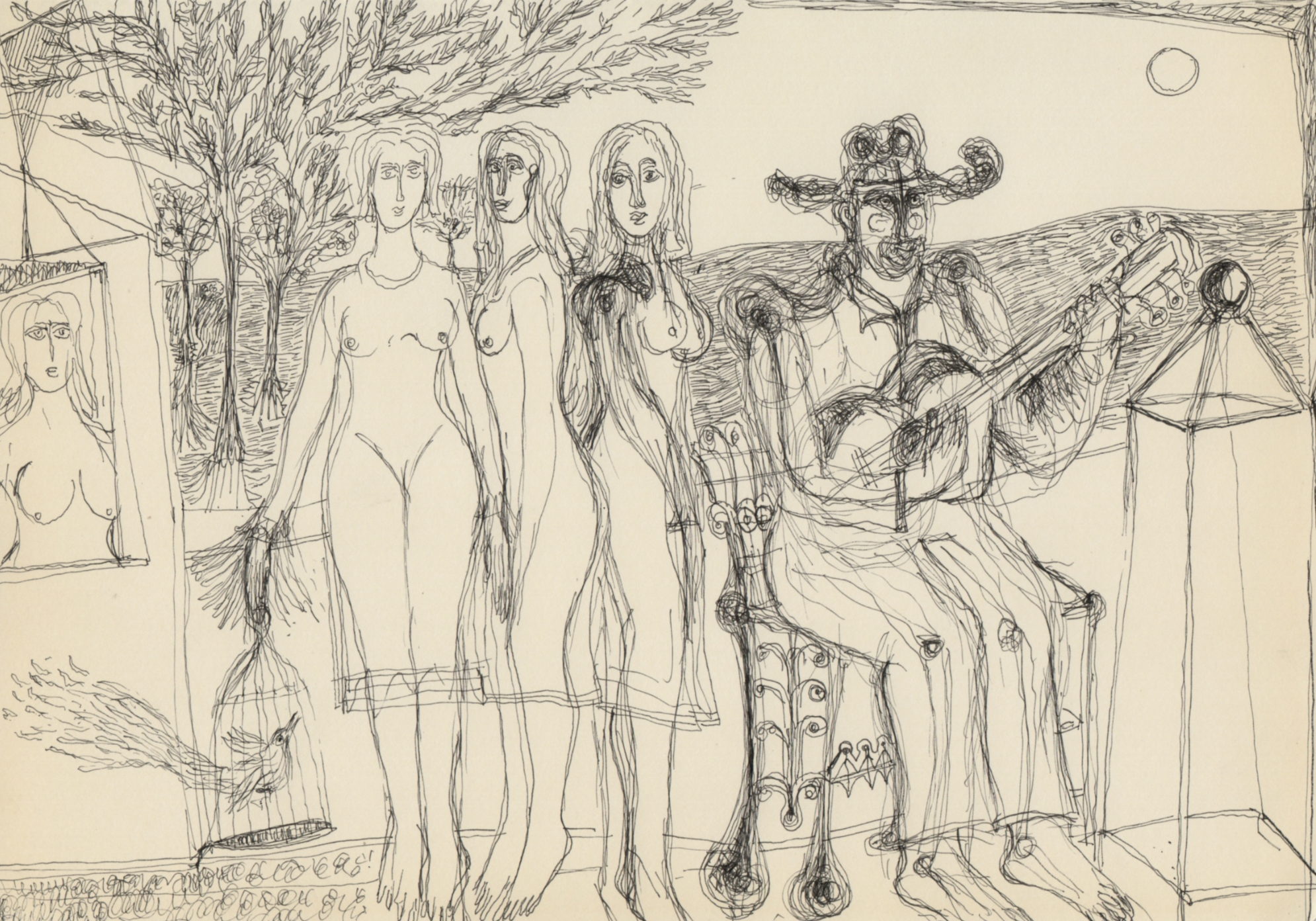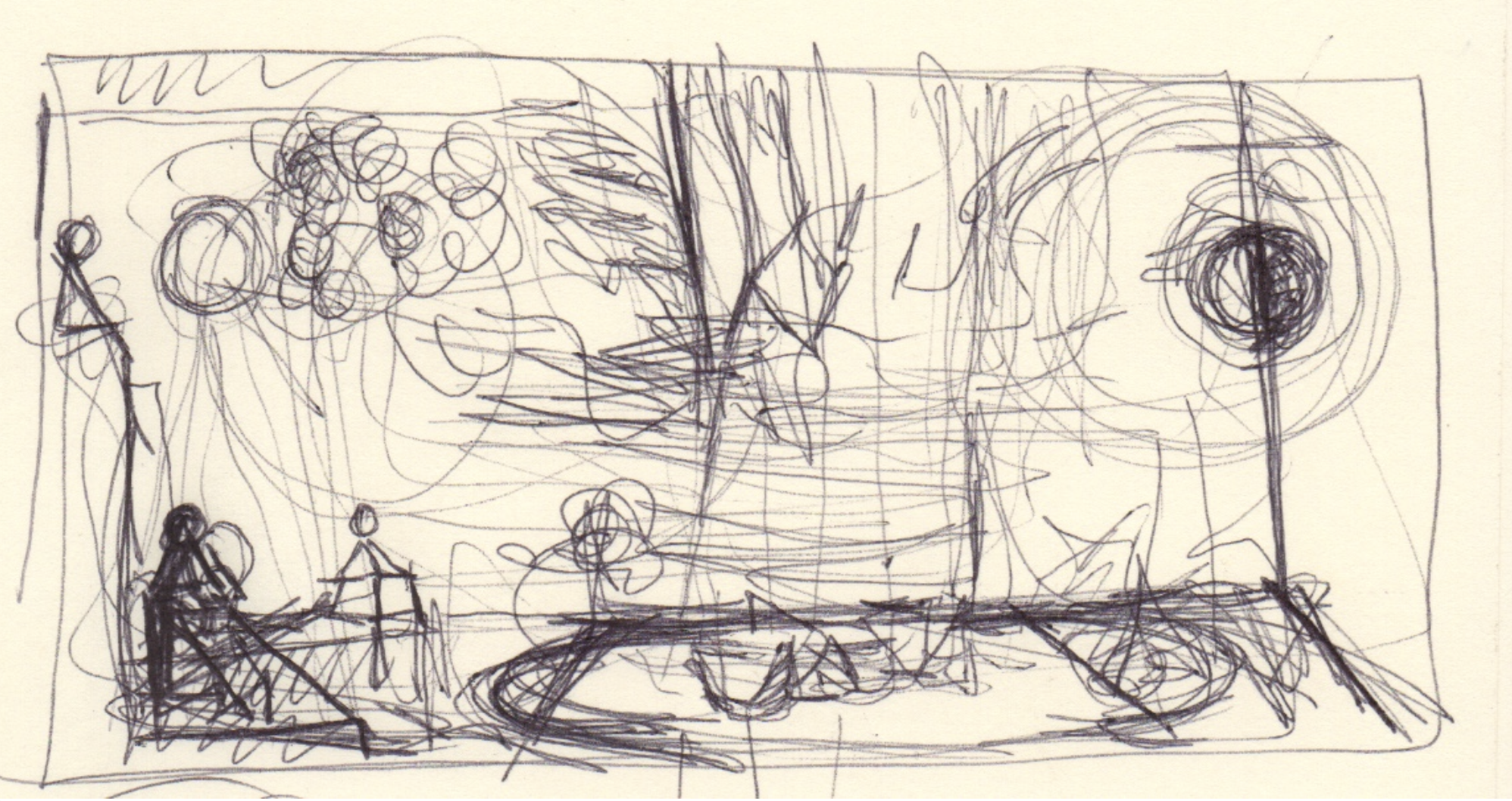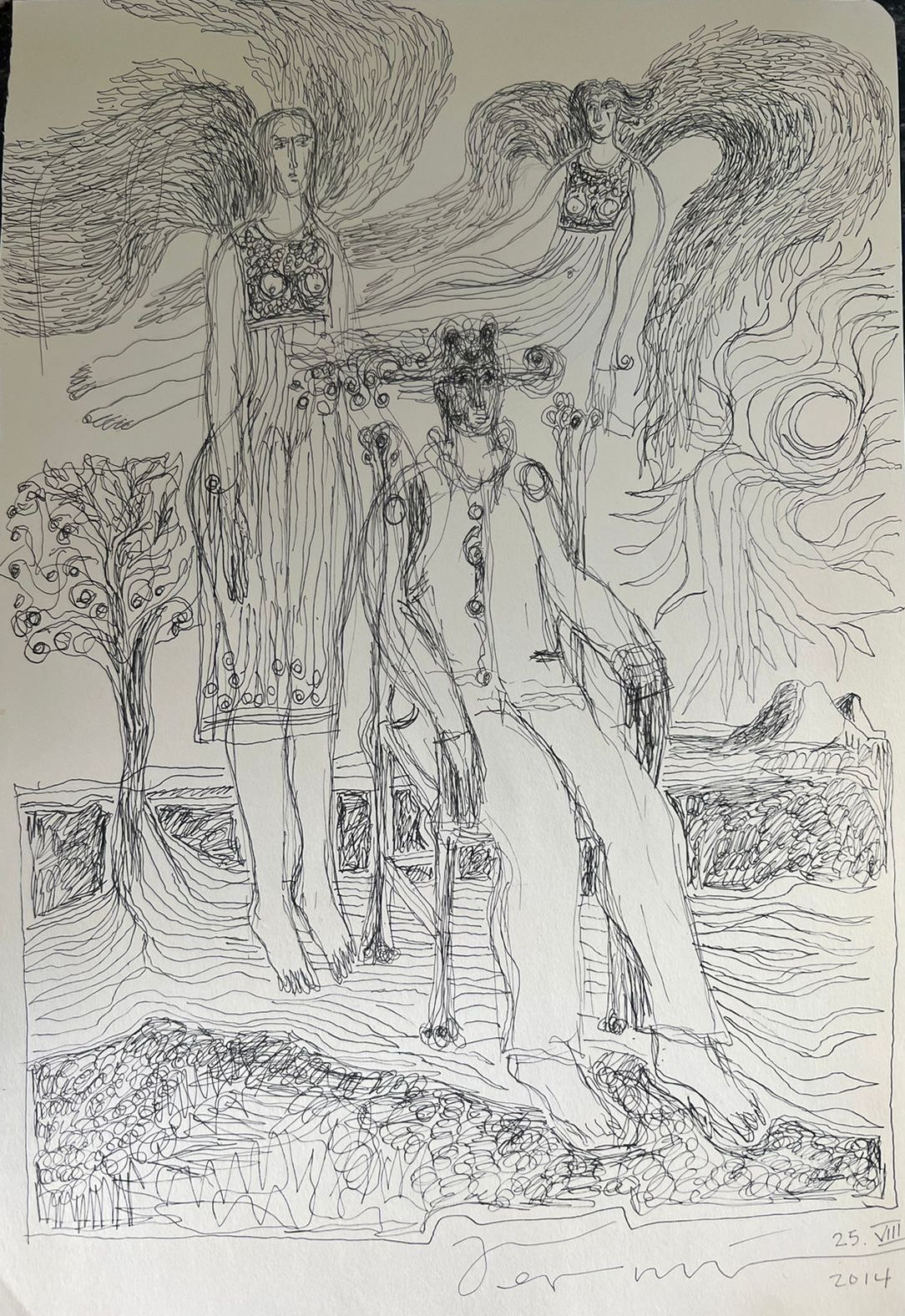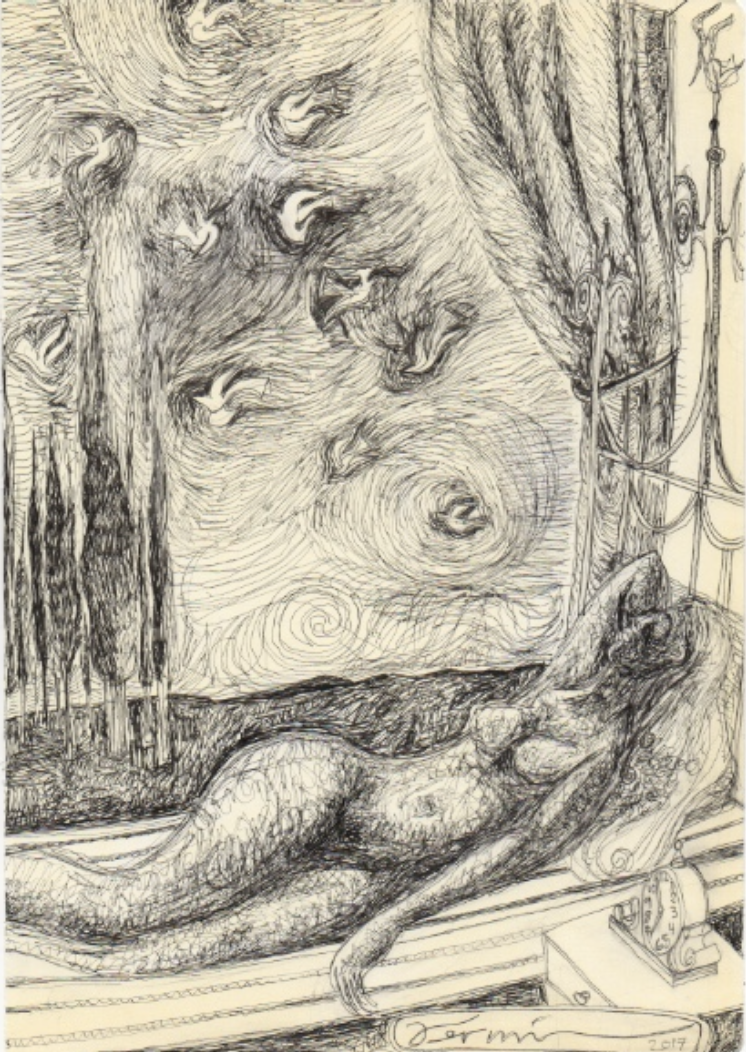CV

BIOGRAPHY

1954
Was born in Parral, Chihuahua, into a family of miners from San Gregorio Valle de Allende, on his father's side and from Minas Nuevas.
1970
He finishes his primary studies at the Article 123 and Leona Vicario 103 school, where he receives his first drawing class from teacher Catarino Rivas.

1972
Works as a portrait retoucher on negatives at the commercial photography studio “El Cisne”. He plans to pursue photography professionally.
1970 - 1975
He finishes his middle school and high school studies. The family emigrates to the state capital. “Chihuahua was a city of mansions and central patios, still with something stately
1976 - 1978
He openly attends the workshops taught by the sculptor Judith Bermudez at the UACH school of fine arts, while he was studying Architecture.

1979
Fermín travels to Europe. Touring England, Holland, Denmark, Germany, Italy, Greece, Austria, France and Spain. “I visited the two great museums in the world in terms of painting: the Louvre and the Prado. I am impressed by El Greco and Velázquez, the unfinished sculptures of Michelangelo, Egyptian art, the work of Rodin. I felt directly what the work of a genius is when I learned about Bernini's work: those perspectives of the Baroque, that capacity for resolution on large scales that have been unsurpassed to this day. An invention through numbers, through geometry. That trip marked me, although at that time I didn't know exactly what was happening to me. "I did not have the theoretical elements to digest what that encounter with great European art represented, but I did have great energy to resolve it in vital terms."
1981 - 1982
He works as an architect in the rescue of architectural heritage and housing. He gets definitively involved with painting. “I had always been restless, but until then I was able to take the time to paint. He painted moons and suns, urban characters. “I painted with vinyl and that's what I spent the little money I had on.”
1988
Attend the engraving workshop taught by the Jimenenze painter Benjamín Domínguez at the Chihuahua cultural center.

1989
First painting exhibition: “Fragments”, held in the lobby of the Heroes Theater of the City of Chihuahua. “It was a proposal that tended a lot towards illustration, with themes related to architecture. My forms and my language were simple but I feel that there was the germ of my later work.
1990
He is invited to exhibit in the United States at the Centennial Museum in El Paso, Texas, where he receives glowing words from the art critic specializing in Latin American painting, Dr. Shifra Goldman, professor at the University of Los Angeles. He receives an offer from the sculptor Sebastián to reside in Mexico City. The sculptor Sebastián dedicates glowing words to Fermín's work and acquires more than twenty of his paintings. A friendship begins that would last to the present.
1989 - 1993
Stay in Mexico City. He works for the Expositum gallery, in Polanco. In 1990 he had the opportunity to listen to Alejandro Obregón: «I had been greatly impressed by her famous motherhood, that woman lying down, with her belly distended, about to give birth. He was a strong character, almost made of steel, with a luminous and quick look. He answered the questions in a forceful way and joked about the fact that art had become vedetism. » That same year he met, at the Palace of Fine Arts, the teacher Rafael Alberti, already very old and in one of his last public appearances. «I was dazzled by the contact of different artistic languages: a man who had had contacts with cubism, with surrealism, also an activist and a living myth.» Exhibitions in the Torre de Comercio, Expósitum Gallery and various houses of culture. “What I liked most about Mexico were its flower stalls, its markets, its flea markets, where smells, colors and flavors violently intersect. The infinite nuances that a northerner discovers in that part of the country that remains so indigenous. The cantinas of Mexico, also missable, but what I liked most were those markets, they are centers where objects, plants, characters, fruits that I had never seen converge. There I discovered true craftsmanship, true popular art. That was my second great school. And the anthropology museum, which I will never get tired of visiting.”

1992
Meet Armando Morales in Mexico City. «On my visit to Mexico City I had a chance meeting at the Rufino Tamayo Museum. He exhibited some paintings in which marine characters, travelers, appeared. There was a great reflection on the light. Painting with trade. I arrived at the conference and, without knowing that he was Armando Morales, I began to talk to him. I had heard a lecture of his on the radio. It was an encounter that greatly influenced me, and what my work would become. From him I learned the infinite universe of what painting is. I understood in a personal way the process that the creator experiences, from the search to the encounter. He was a painter who showed me, with simple words, and in a simple way how work, by itself, guides you and you simply have to wait for results. He traveled to New York, where he dedicates himself to touring museums. “I went to see the great canvases as if they were great ladies whom I had to go and greet: The Crucifixion by Francis Bacon, Moulin à Chocolat by Marcel Duchamp, The Dance by Henri Matisse and one of the many constellations by Joan Miró ”.
1993 - 1995
In '93, in Mexico City, he met the sculptor Edgar Negret. “It was a wonderful meeting. I discovered an elemental, sensual, fine, elegant sculpture, belonging to the Latin American geometric school. We talk about materials, joints, movements. He told me a lot about his monumental projects and the tradition of the Incas. He was an almost silent man to speak. As if his lips were not moving. A fragile character, however when we see his work we find great vigor: metallic folds, lipped mantles, movement. He stays in Sao Paulo, Brazil. “A sensual and sexual country, thrown into the sea, with half of its being still in the sea, with one foot in the sea and the other in the jungle, full of bars, cantinas, restaurants, girls who smell like coconut. A country in which all forms of human contact are easier.” Exhibition in the Flavio Imperio gallery. “I was dazzled by the works of Oscar Niemayer, Lina Bonbardi, Iberé Camargo, Candido Portinari, Cicerón Díaz, some of the greatest achievements of Latin American talent. I was also fascinated by Brazilian music, bossa nova, samba. “Brazil: a green beach, full of music, joy and mystery.”

1995
“I return to the desert, where I should never have left. My house. The north, the land of dry heat, welcomed me with its starry sky, with its voids, with those shadows full of light, with those sunsets that are logs in embers, half extinguished. I realized what it was like to live in the desert: if you drink papaya and lemon water on a terrace in the city of Chihuahua it tastes delicious, it's like a privilege. But if you take it in Yucatán it is paradise. And on the contrary: if you eat corn atole with piloncillo in Mérida it is an eccentricity, but if you eat it in San Gregorio, Chihuahua, it is like carrying the sun in your gut. That is why the landscape is part of man and determines in many ways his speech and his most intimate accents. For the rest, unpleasant surprises also awaited me: I found a city in Chihuahua even more destroyed than the one I had left, where the walls, the doors, the ancient wooden windows that I had left a few years ago no longer existed. He organizes an exhibition titled “Round Trip,” a graphic summary of his Brazilian experience.
1996
He receives the Plastic Arts Award from the Autonomous University of Chihuahua for the painting “Piedra Solar”. She creates the serigraphic series “Búsqueda por la Pasión” inspired by the story “El Gallo de Oro” by Juan Rulfo.
1997
Honorable mention in the Binational Siqueiros-Pollock Award. She creates two large-format paintings for the Chihuahua City Convention Center: “Urna Solar” and “Urna Lunar”. “Two large spaces in which I wanted to portray the duality of Chihuahuan physical time. In the daytime part I portrayed fossils, minerals, my father's work, desert fauna and, above all, the textures of the desert. But also to that ghost that appears in many places, in prisms, in minerals, even in cans, if we place its metal against the light, but that nowhere appears in such a definitive and beautiful way as in the sky after the rain: the rainbow. The Lunar Urn is a painting that recreates the atmospheres of the northern night: the moonlit nights, of country banquet parties. The world of ranches, with sotol and guateque, with cold but with a bonfire, in the middle of the desert but with turkey in mole. One paints what one is. It is a painting focused on composition but also on color. I am a northerner, son and grandson of miners. In short: I wanted to make a portrait of my origins.” He is invited to be part of the Art Pace program, in which he could not participate due to work issues.

1998
Receives the Siqueiros-Pollock Award. He exhibits “Travesías” at the University of New Mexico. “The only thing I remember about New Mexico is that, in effect, it was another form of Mexico; a place where, no matter how much they want to varnish them with Hispanicity or Anglo-Saxon modernity, Mexicanness continues to emerge as soon as you scratch them and wherever you scratch them.” Collective exhibition “Plastica Chihuahuense” at the José Luis Cuevas Museum, in Mexico City. After this exhibition, he participated in a round table with the painter José Luis Cuevas entitled "Mexican Muralism." “We had conflicting points: he claimed that muralism was dead. It was too personal a position. I express opinionsI express opinions to the contrary, in the sense that muralism was simply a format option, a specific way of expressing oneself that had not lost any validity. At the end he approached me and congratulated me. Then his wife Berta also approached me, now deceased, and jokingly told me: Very good, very good; It's good that you tell him those things."
2000
Inauguration of the monumental sculpture “Tree of Victory” in Ciudad Juárez. “A sculpture with an organic language, in which I sought dynamism and communion with the difficult environment of a border city. A sculpture that had the secret mission of ordering and measuring the chaos in whose center it was to be placed: nothing less than a cruise ship in Ciudad Juárez.” The project for the “Las Palomas” monumental complex for the metropolitan park of the city of Chihuahua begins.
2001
Exhibition in Ville d'Angiers, France. The monumental complex “Las Palomas” is inaugurated in the Parque del Palomar, in the city of Chihuahua. Inauguration of the mural “La Familia”, in the Municipal Media Library of the City of Chihuahua.

2002
Exhibition at the autumn salon, in Paris, France, along with other Mexican painters. “Memory of the Days” Exhibition, at the Technological Institute of Monterrey.
2003
He receives the Chihuahua Prize in Plastic Arts for the sculpture “El Gallo”. “The rooster belongs to me as much as it belongs to the morning. It is a very strange animal, which has everything: beak, wings, claws, razors, crest, dewlap and to top it off orange eyes. I started modeling it one morning. It was born from an impulse. I wanted to make a rooster made of moons and suns. “I grew an arm that holds the moon: its beak.” Visit to Havana, Cuba. “A beauty from the moment you arrive and discover that island that looks like a huge, dilapidated ship. Those earthy, greenish textures, those water mirrors. A country of very subtle atmospheres but equally of spirited movements, surprises and shocks. A country of downpours that make Havana disappear in vapor, as if it had been a mirage. I had some of those downpours. I remained absorbed in these disappearances until the Cuban men and women began to reappear, as theater characters, as actors. Gabriela and I walked through that center of true palaces, corridors and patios filled with dirty marble, bars and walls that were peeling but majestic. Havana, that city of great writers, that city in which none other than Paradiso, by the great José Lezama Lima, was written. Havana is a city of magicians. One sunny day, a friend took me to meet a painter who lived near the reserve, in a small house half brick and half wood. The painter took out a canvas to the patio with a yellow and white base. Almost humid, cold from the heat of Havana. Then he took a bag with objects and began to pin feathers, cables, crow's feet, flowers, horsetails on it; He began to spread dirt and powder on it, and to stick photographs on it. In half an hour he had the painting ready, leaning there against a Havana tree.”

2004
Retrospective exhibition at the Casa Redonda museum, in the City of Chihuahua: “Secrets of the Desert”. “It was a broad set of topics related to water, which is so valuable to us, but also to the night. A zoology appears that I had not dealt with: fish. I leave the dogs behind, but I meet the fish and the birds, especially the nocturnal birds, which are the most beautiful. Sleeping women bathed by night and covered by flocks of chanates that travel towards a sky that rests in cobalt blues.” An agenda is printed in which art photographers collaborate, aimed at disseminating images of the “Las Palomas” sculpture complex, with texts by the Colombian architect Mauricio Pinilla and the Mexican Gabriel Escárcega.
2005
Project the sculptures “Nosotras” and “Our House”. “The first response to the painful situation of women on the border. The second is a metaphor about the family, with all its components, its contradictions and its spaces of light.” He exhibited in Oaxaca with two other Chihuahuan artists: Luis Aragón and Benjamín Domínguez. “Luis Aragón: a painter of the desert. His material is stone. His hour is twilight. A painter very concerned with showing what the desert is. We have had many adventures together. A man of the mountains, a true mountain man, a man of the ravines and the cliffs. Benjamín, for his part, is a generous and committed painter, with the profession and with those around him. An alchemist who speaks the language of mystery. “Two Chihuahuan teachers.”
2006 - 2009
I exhibited in several cities in the United States, such as Huston, San Diego, Dallas, I received a scholarship at the University of Las Cruces, New Mexico, and I had a great exhibition at the University.

2010 - 2014
The monumental sculpture El Abrazo is made, an emblematic work for the tricentennial park located in the Rejón dam; Realization of the large-format monumental work in bronze “the Family” for the interior park at the BAFAR company; Preparation of sculpture “The Angel of the Annunciation” 2.30 meters high.
2015 - 2020
Exhibition called AZOGUE at the Casa Chihuahua Cultural Center, exhibiting 20 large-format works as well as several works of bronze sculpture called Alborada, The Angel of the Annunciation; Exhibition in the “Esquina del Arte” gallery in the "Distrito 1" in the city of Chihuahua.
2021 - 2023
Years dedicated to the process of creating several works in Oil and Pigments, in which he participated in several auctions in the country of Mexico, creation of works in bronze such as the Kiss, Lumbrera and elaboration of several designs in Silver and Gold Jewelry such as Moebius; Preparation of a silk-screen work called “Space and Form” for the Architecture institution in its 30 years of foundation; A memorial for the death of Francisco Villa is held in the Pantheon of Cd. Parral Chihuahua.

